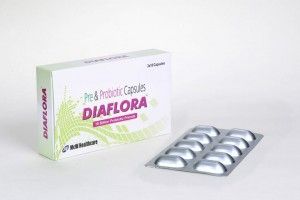| Lactobacillus casei | 1.0 billion cfu |
| Lactobacillus rhamnosus | 1.0 billion cfu |
| Lactobacillus plantarum | 1.0 billion cfu |
| Lactobacillus reuteri | 1.0 billion cfu |
| Lactobacillus sporogenes | 1.0 billion cfu |
| Lactobacillus acidophilus | 1.0 billion cfu |
| Bifidobacterium longum | 1.0 billion cfu |
| Bifidobacterium breve | 1.0 billion cfu |
| Streptococcus thermophilus | 1.0 billion cfu |
| Sachromyces boulardii | 1.0 billion cfu |
| FOS | 100 mg |
Human beings are associated with a large and diverse population of microorganisms that live on body surfaces and in cavities connected with the external environment. The skin, mouth, vagina, upper respiratory tract, and gastrointestinal tract of humans are inhabited by site-specific microbial communities with specialized structures and functions. Most of them come under the classification of Probiotics.
Probiotics have been described as “live microorganisms that, when consumed in adequate quantities, confer a health benefit on the host.”There are an estimated several trillion friendly bacteria comprising over 400 species in the average human gastrointestinal tract. By body weight, each of us carries around nearly four pounds of intestinal microflora. When the intestines are healthy, there are more friendly bacteria than non-friendly or pathogenic ones.
Normal Gastrointestinal Flora & Intestinal Ecosystem
The human intestinal microflora is highly important to the host for several reasons. Firstly, microflora benefits the host by increasing resistance to colonization by potentially pathogenic microorganisms ingested through food and water, causing GI disorders, as well as by protecting against the overgrowth of already present potentially pathogenic organisms.
Another function important to the host is the high metabolic activity of the intestinal flora, helping in the digestion process in the intestine. Indeed, it is now known that the normal gut flora plays an important role in maintaining good health by stimulating the immune system, aiding the digestion and assimilation of food and protecting the host from invading bacteria and viruses.
The composition of the GI flora differs among individuals and also during life within the same individual. Many factors, such as diet or climate, aging, medication (especially antibiotics), illness, stress, pH, infection, geographic location, race, socio-economic circumstances, lifestyle can upset this balance.
Interactions of the typical bacteria may also contribute to stabilization or destabilization of the gut flora. A state of balance between the microbial populations within the GI tract can be called “Eubiosis” while an imbalance is termed “Dysbiosis”.
For optimum gut flora balance the beneficial bacteria, such as the gram positive Lactobacilli and Bifidobacteria, should predominate, presenting a barrier to invading organisms. Around 85% of the intestinal microflora in a healthy person should be good bacteria and 15% may be bad bacteria.
Role of probiotics in IBS
- Mucosal adherence + inhibition of pathogenic bacteria adherence
- Enhanced barrier function of intestinal epithelium inhibit the increase in gut permeability induced by E. coli
- Check the growth of pathogenic bacteria Secrete bacteriocins. Acidify the colonic contents Increases the number of fecal Bifidobacteria and Lactobacilli. Reduces the number of Clostridia
- Immunomodulatory action Increase IL-10 secretion (IL-10 is an anti-inflammatory cytokine) Decrease TNF, IL-6 and interferon secretion
- Inhibit visceral hypersensitivity Anti-inflammatory effect Inhibit substance P (marker of pain pathway)
Advantages of Multispecies Probiotic
- Greater variety of antimicrobial compounds
- Synergistic effects – improves functionality
- Enhanced intestinal adhesion
- Ability to colonize several niches of GI tract
- Broader effect on motility disturbances
- Direct effect of the administered strains
Bacterial Vaginosis
Most common vaginal disorder in reproductive women characterized by Raised vaginal pH (>4.5),Overgrowth of unhealthy anaerobes, Reduction of lactobacilli
Lactobacillus and vaginal pH
The low pH of the vagina is attributable to production of lactic acid by Lactobacillus metabolism. Anaerobes grow poorly at pH 4.5 or less; the optimum pH for Prevotella spp and G vaginalis growth is 6–7. Low pH also appears to be important for Lactobacillus adherence to the epithelial cells. At pH of 4.4, a mean of 5.5 Lactobacillus adhered per vaginal cell, compared with 1.4 at pH of 6.2
Dose
Adults: 1-2 capsules daily
Presentation
Alu-Alu strip of 10 caps, Box of 3 strips


